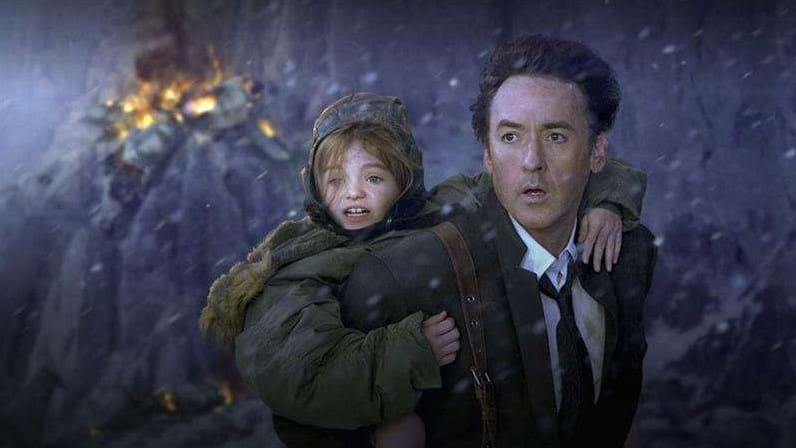Disaster Daddy Movies and Escapism: "2012"
The comfort of a savior.

I feel like I'm always five minutes away from watching 2012.
You see, I’ve been a movie fan my whole life, and some 20 years ago I started writing about them. Examining and critiquing film shaped me. It expanded my empathy and critical thinking, but it also forced me to look inward in ways that made me feel exposed. Movies, and stories in general, taught me about myself. Unfortunately, most of what I learned was unpleasant—obvious things I struggled to realize on my own. Icky, but important nonetheless. When your relationship with something is that intimate and telling, you kinda have to listen when it speaks. So, I kinda had to pay attention when my classic “comfort movies” began falling away, replaced by flashy disaster flicks and depressing post apocalyptic slogs.
It made me realize I wasn’t doing well. At all.
Like many of us, I’m still in the pandemic. It never stopped—there was no break. I’ve been masking since early 2020 and don’t plan to stop. I’m chronically ill and suffered many of the symptoms associated with Long COVID well before COVID was a thing. Nothing is worth my health at this point.
Like many of us, I’ve been worried about climate change since I was in elementary school. I used to have panic attacks—in the ‘90s—about single-use plastic. About trees. About the ozone layer. I couldn’t understand; if we all knew about it, why weren’t we doing anything?
Like many of us, I worry about water and food and resources and collapse and and and…
I worry. I worry so much that I struggle to hold onto it all. But I don’t want to drop it, because, like many of us, I know that turning away isn’t an option—at least not a good one.
All that’s left is to try and cope. And, as I’m sure you’ve guessed by now, my main coping mechanism is movies and media. Early in the pandemic I was predictably hesitant to watch anything too bleak. I actively avoided death and violence. I wanted things soft and squishy and that went on for over a year. But as the already gaping chasm of cognitive dissonance began to widen, I noticed a pull towards the things I’d been so adamantly avoiding.
Outbreaks. Zombies. Disasters.
Sometime in late 2021 I started repeat-watching the 2009 Roland Emmerich disaster fest 2012. If you’ve never seen it, 2012 follows multiple groups as they attempt to navigate a natural disaster. Honestly, that’s the basic plot of pretty much every disaster movie, but 2012 also has John Cusack, and as a massive fan, I figured that was the root of my fixation. Years of playing disenfranchised and imperfect men had shaped him into the perfect Disaster Daddy: competent, quick, and a real problem solver. 2012 sees him defying all logic and sense to guide his fractured family to safety.

Around the third watch through in as many weeks, I was forced to come to terms with the fact that it was bigger than being super into John Cusack. I mean, High Fidelity exists.
Somehow, 2012, a movie about the liquidization of the earth’s core and subsequent decimation of the majority of the population, was making me feel good. It was allowing me to escape. And I had to ask myself, why?
The answer, I found, was upsettingly simple. In 2012, even as the White House is demolished by a tsunami, the people in charge had a plan. They built boats—arks—to carry the ultra-rich and powerful to safety. It wasn’t an inclusive plan, and they certainly didn’t communicate the growing threat (which is super believable), but they were doing something. What a novel idea, doing something. Planning. Things are so bleak that even the fictional facade of competency is a welcome escape. Even if it’s pretend, it feels hopeful. Because John Cusack and his family weren’t ultra-rich and powerful. They were just lucky. They had hope.
Another quaint plot point in 2012 is that a geologist discovers the rapidly heating core and reports it. And then people listen. They believe him. Governments jump to action. Can you imagine? Listening to science? This mostly throwaway detail has become one of the most unbelievable aspects of this massively unbelieve film. Now, it plays like hardcore sci-fi—the ultimate wish fulfillment. A way to escape.
Disaster movies are patriarchal cesspools. The president or your dad or the military (or all three) will save you. They’ll swoop in at the last minute and fix it all—or most of it. And even if islands in the South Pacific are ablaze, and the East Coast has fallen into the sea, there’s a happy ending waiting for some of us. I never enjoyed the “trust daddy to make it all better” undercurrent. Now I crave it. Please, Disaster Daddy, give me the illusion of protection. Grant me the gift of hope.
Once things get going, they move fast in 2012. They move fast in most disaster films. That’s kind of the whole point, and it’s become a little enviable. No one has any time to sit and wonder how bad it’ll get. There’s not years of shuffling toward the apocalypse. It shows up, does its worst, and then the survivors deal with what’s left.
Imagine there being something left. It’s euphoric.
In the end, John Cusack and fam are let on the ark because they represent hope. You see, our hero is actually a writer, and his book works as the blueprint for community building in the end times. What a coincidence! What a beacon. What a hopeful lie.
I’m always five minutes away from watching 2012 because I’m always a headline away from collapsing under the weight of the worry I carry. But when Cusack shows up on screen, deftly driving through collapsing skyscrapers, I can put it all down. My Disaster Daddy will take care of everything and I can pretend there’s hope. For now, that’s gotta be enough.
Watch out for each other out there.







